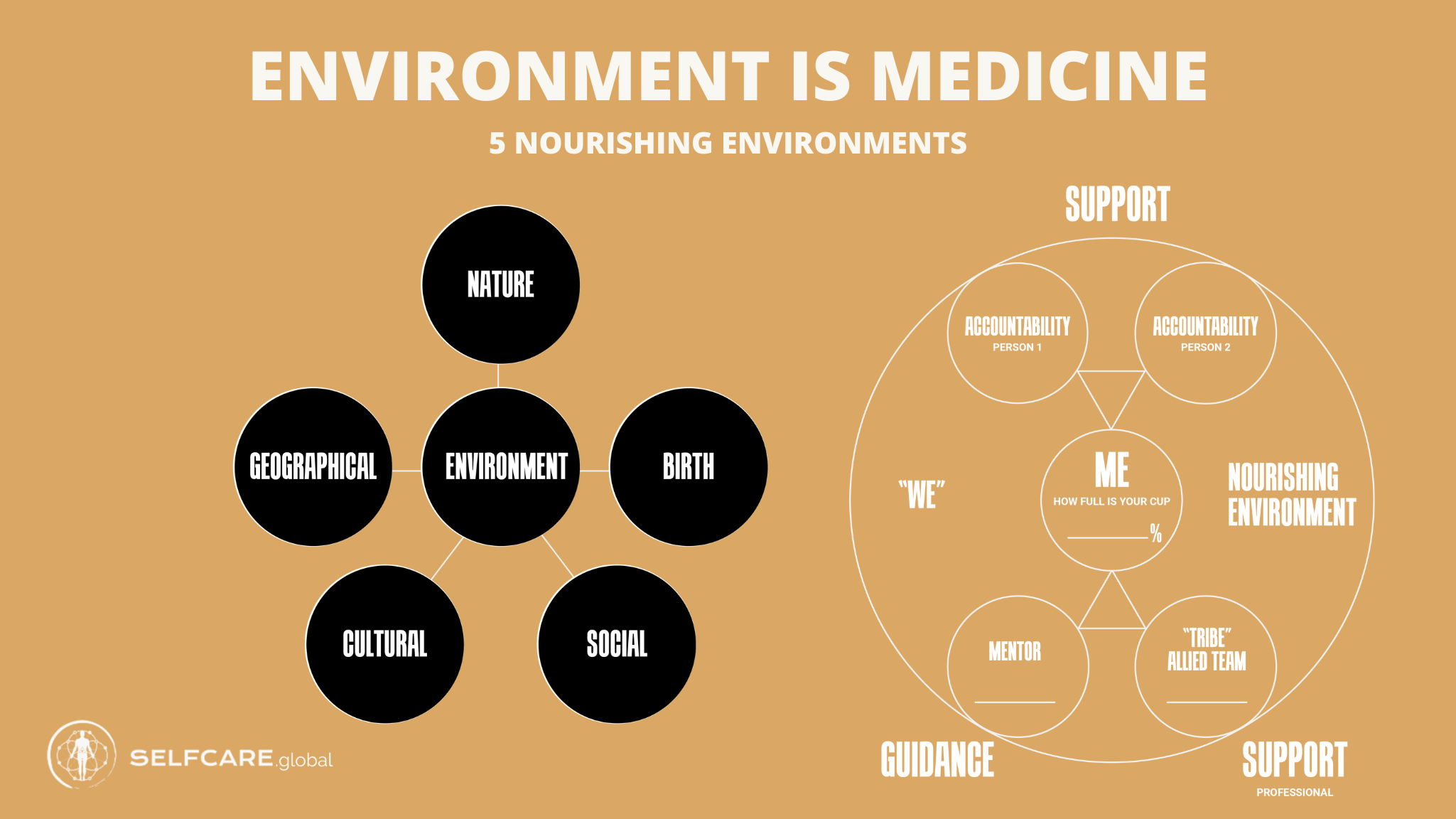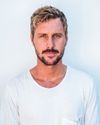The Hidden Power That's Shaping Your Wellbeing
Have you ever noticed how certain spaces make you feel immediately calm, while others leave you feeling drained and stressed? This isn't coincidence—it's the medicine of environment at work.
When I was treating thousands of patients in hospital settings, I witnessed firsthand how dramatically a person's healing trajectory could change based on their environment. But it wasn't until I personally hit burnout that I truly understood: no amount of individual willpower can overcome a toxic environment.
In my book "Lifestyle Medicine For the People", I share how environment is one of the most overlooked yet powerful medicines available to us. The spaces we inhabit are constantly speaking to our nervous system, influencing our choices, and either filling our cup or draining it dry.
The 3 Major Challenges We're Here to Solve Together
- The Passive Environment Trap: Most people unconsciously design their surroundings based on convenience rather than wellbeing, creating spaces that perpetuate stress, burnout, and disconnection.
- The Willpower Myth: We've been taught that health requires enormous discipline and willpower, when in reality, our environment's subtle cues drive 90% of our daily choices without our awareness.
- The Digital Takeover: Our attention environments have been colonized by technology designed to hijack our focus, leaving us feeling perpetually exhausted, unfulfilled, and disconnected from what truly matters.
Would you be open to exploring how small, intentional shifts in your environment could transform your wellbeing more effectively than years of struggling through willpower alone? Our SelfCare Community is filled with people discovering just how powerful these environmental medicine principles can be when shared and implemented together.
The SelfCare Framework: Learn-Do-Embody-Teach
1. LEARN: Understanding Environment as Medicine
Your surroundings are not just aesthetic choices—they're prescriptions for your nervous system, energy, and choices. Research in behavioral design shows that your environment's invisible architecture determines up to 90% of your daily decisions.
2. DO: Creating Environments That Heal
Small, strategic changes to your physical and digital spaces can dramatically reduce stress, boost energy, and support wellbeing without relying on willpower.
3. EMBODY: Becoming Your Environment's Designer
Moving from passively accepting spaces to actively creating environments that align with your health values changes your relationship with your surroundings.
4. TEACH: Ripple Effects of Environmental Wellbeing
As you transform your spaces, you naturally influence those around you, creating healing ripples that extend far beyond your personal environment.
The Driver's Seat: Taking Control of Your Environment
Most people live as passengers in environments designed by default or by others' priorities. Your home, workplace, digital spaces, and even social environments were likely not consciously created with your specific wellbeing in mind.
The research is clear: willpower is a limited resource, but environment is a renewable one. A landmark study in the journal Personality and Social Psychology Review revealed that people with the strongest self-control rarely use willpower at all—they simply design environments where healthy choices happen naturally.
What if I told you that taking the driver's seat in your environmental design could transform your wellbeing more powerfully than any amount of discipline or motivational quotes? This isn't about buying expensive furniture or moving to a new home—it's about conscious curation of the spaces that shape your life.
The first step in environmental medicine is a simple awareness shift. Look around your current spaces and ask: "Is this environment designed to heal or harm? Does it fill my cup or drain it? Is it creating the person I want to become or reinforcing who I've been?"
This is precisely why in my SelfCare book, I emphasize environmental design as one of the foundational medicines—because until you address your surroundings, other wellness practices will always be swimming upstream.
The Environment Audit: Your First Step to Transformation
Let's begin with a simple but powerful practice: the Environment Medicine Audit. Choose one space where you spend significant time (your bedroom, workspace, or even your digital environment), and assess it through these four lenses:
- Sensory Environment: What messages are your senses receiving? Is there natural light, pleasing sounds, comfortable temperatures, and textures that soothe rather than stimulate?
- Choice Environment: How does this space influence your decisions? Are healthy options visible and accessible while unhealthy ones require more effort?
- Energy Environment: Does this space drain or enhance your energy? Are there elements that inspire, uplift and recharge you?
- Connection Environment: Does this space support meaningful connection to yourself, others, nature, or purpose?
For each area, rate your current environment on a scale of 1-10, with 10 being optimal for wellbeing. You'll likely notice patterns where certain spaces consistently score low across multiple dimensions.
This isn't about perfection—it's about awareness and small shifts. Research shows that even minor environmental changes can trigger significant behavioral and physiological responses. A study published in the Journal of Environmental Psychology found that simply adding plants to a workspace improved cognitive function by 15% and reduced stress hormones by 37%.
May I ask—which of your daily environments scored lowest in your quick mental assessment? That's likely where the greatest opportunity for transformation lies.
The 1% Environmental Upgrades
The philosophy of Kaizen—improving 1% each day—applies beautifully to environmental medicine. Here are six small environmental shifts that research shows can dramatically impact wellbeing:
- Create a nature connection point in every room where you spend significant time. Studies show that even viewing images of nature for 40 seconds can reduce stress and improve focus. A small plant, nature photograph, or window view can serve as a micro-dose of nature medicine.
- Establish transition thresholds between different contexts in your life. The simple act of creating a brief ritual when moving between spaces (home to work, work to relaxation) helps your nervous system reset and prevents burnout contamination across life domains.
- Design for the Default. Make the healthy choice the easy choice by keeping nourishing foods visible, exercise equipment accessible, and digital boundaries automated. This approach bypasses willpower entirely.
- Curate your attention environment by removing unnecessary notifications, creating tech-free zones, and scheduling "deep work" periods where digital interruptions are blocked completely.
- Incorporate movement invitations throughout your spaces. Standing desks, floor cushions, balance boards, and strategically placed items that require movement all contribute to an active environment that prevents the stress of prolonged sitting.
- Create emotional resonance anchors in your key spaces—objects, images, or elements that remind you of your values, purpose, and sources of joy. These serve as subtle but powerful reminders that redirect attention to what truly matters.
The beauty of environmental medicine is that once implemented, these changes continue working for you whether you're thinking about them or not. Unlike practices that require constant vigilance, environmental design creates ongoing support for your wellbeing.
What if I told you that implementing just one of these upgrades per week could transform your environment—and by extension, your health—within six weeks? This is how environmental medicine compounds: each small shift creates ripple effects across multiple health dimensions simultaneously.
In the SelfCare community, members often share photos of their environmental transformations, creating inspiration and accountability that amplifies the impact of these changes. Nothing is more powerful than seeing how others have applied these principles in real-world contexts.
From Doing to Being: Embodying Environmental Awareness
The true power of environment as medicine emerges when you shift from occasionally optimizing your surroundings to becoming someone who naturally creates healing spaces wherever you go.
This identity-level transformation happens through consistent practice and awareness:
- Begin noticing how all environments affect you. Develop the habit of asking "How is this space making me feel?" whether you're in a café, friend's home, or natural setting.
- Practice environmental boundaries by gracefully declining to spend time in spaces that drain your energy or compromise your wellbeing.
- Become a conscious creator of micro-environments even in spaces you don't control. Something as simple as where you position yourself in a room, the music you choose, or bringing a comforting object can transform your experience.
- Extend environmental awareness to your relationships, recognizing that social environments affect health as powerfully as physical ones. Curate connections that energize rather than deplete you.
This embodiment practice transforms environmental medicine from something you do occasionally to something you are consistently—an environmental healer who naturally creates wellbeing-supporting spaces with your presence.
Remember: "Environment is not what surrounds you, but what flows through you." When you embody environmental awareness, you become both the healer and the healed through the spaces you create.
Your Environmental Medicine: Ripples of Transformation
As you transform your environments, something remarkable happens: you naturally influence the spaces around you, creating ripples that extend far beyond your personal surroundings.
When you design your home to support authentic connection, visitors feel it. When you transform your workspace to enhance focus and creativity, colleagues notice the difference. When you create boundaries in your digital environment, you inspire others to reclaim their attention.
This is why environment is such a powerful medicine—it naturally creates community impact without requiring you to convince anyone of anything. You simply model a different way of relating to spaces, and others experience the benefits directly.
In our SelfCare community, we've seen stunning examples of how one person's environmental transformation catalyzes change for entire families, workplaces, and friend groups. A mother who redesigned her kitchen for mindful eating influenced her children's relationship with food. A manager who introduced nature elements to team meetings noticed improved collaboration and reduced stress.
These ripple effects happen naturally when you serve from overflow—when your own cup is filled by supportive environments, you naturally share that medicine with others.
Your Next Step: The One-Room Environmental Reset
Ready to experience how environment can transform your wellbeing? I invite you to choose one room—ideally where you start or end your day—and commit to a complete environmental medicine reset.
First, remove everything that doesn't actively support your wellbeing: clutter, distractions, items that trigger stress or negative emotions.
Then, mindfully reintroduce elements across the four environmental dimensions:
- Sensory-supporting elements: natural light, pleasant sounds or silence, comfortable textures
- Choice-supporting elements: default settings that make healthy choices easier
- Energy-supporting elements: items that inspire and uplift
- Connection-supporting elements: reminders of meaningful relationships and purpose
Document this space before and after, noting how it makes you feel each time you enter. Within just one week, you'll likely notice significant shifts in your mood, energy, and choices—all without relying on willpower.
This single room becomes your wellbeing anchor—a living example of how environmental medicine works and a sanctuary that replenishes your resources for everything else you do.
Would you be curious to share your environmental transformation journey with others who understand its power? Join our SelfCare community where thousands of people are exploring how environment becomes medicine when consciously designed.
And if you're ready to dive deeper into all twelve SelfCare medicines—including how environment connects with movement, mind, food, and other healing practices—my book "Lifestyle Medicine For the People" provides the complete framework for creating wellbeing that lasts.
Remember: Your environment is shaping you every moment of every day. When you take the driver's seat in designing those spaces, you transform not just your surroundings, but your entire health trajectory.

PRESCRIPTION
ONE Recommendation (6-year-old version): Choose your favorite spot at home and make it your special "feel-good place" with things that make you happy, like stuffed animals, pictures, or plants, and spend time there when you need to feel better.
ONE Recommendation (SelfCare.DR): Implement a "Nature Connection Point" in the three spaces where you spend the most time each day, incorporating either live plants, nature imagery, natural materials, or a window view to provide regular micro-doses of environmental medicine throughout your daily routine.
Key Research References:
- Thaler, R.H., & Sunstein, C.R. (2021). Nudge: The Final Edition. Yale University Press. (Comprehensive analysis of how environment shapes choices)
- Ulrich, R.S., et al. (2019). Effects of healthcare environmental design on medical outcomes. Journal of Environmental Psychology, 68, 101-125.
- Browning, W.D., Ryan, C.O., & Clancy, J.O. (2014). 14 Patterns of Biophilic Design. Terrapin Bright Green LLC. (Research on nature connection in built environments)
REFERENCES
This is directly referenced from the Amazon best-selling SelfCare Book "Lifestyle Medicine For the People" by Rory Callaghan. If you would like to read more content like this, grab the free online chapters of the book or a hard copy.
We have done our best to reference everyone's expert opinions, peer-reviewed science, and original thoughts, all references available here and referenced in the text.
We also understand that most thoughts are not our own and there is a collective unconsciousness, unconsciousness, and universal mind stream of energy that is always at work. How our references are sorted and filtered is here.
This article is for informational purposes only and should not replace professional medical advice. Always consult with your healthcare provider before beginning any new health regimen.



